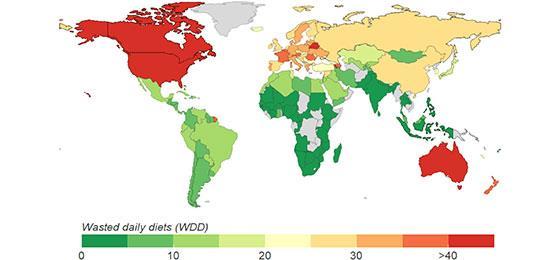Food waste reduction has positive nutritional and environmental outcomes
15.12.2020
In a world with limited resources and an increasing population, we need a more sustainable use of resources along with consumption behaviour adaptations, including the reduction of food waste. Moreover, reducing food waste can contribute positively towards multiple sustainable development goals (SDGs). The research team at the ETH Zurich carried out a global assessment of national food waste of 151 countries and analysed the associated nutritional and environmental losses.
The results show that a global average of 65 kg of food is wasted per year per person. 25% is wasted vegetables, 24% cereals and 12% fruits. The rest are other food categories such as dairy (9%), roots & tubers (6%), meat and fisch (5%) and other (19%). This amount of food waste could provide a healthy diet for one person for 18 days. The embedded environmental footprints in an average person's daily food waste are: 124 g CO2 eq., 58 liter freshwater use, 0.36 m2 cropland use, 2.90 g nitrogen and 0.48 g phosphorus use.
Different countries have widely varying nutrients and environmental footprints embedded in their food waste entailing country-specific waste behaviour and reduction interventions. High-income countries waste six times more food (per capita) than low-income countries, and the embedded environmental impacts are ten times higher than in low-income countries.
The combination of nutritional and environmental quantitative analysis can increase the perceived value of food waste. A high reduction in food waste is needed to achieve SDG 12 ‘Sustainable Consumption and Production’. The results contribute to the existing efforts on investigating food waste across the globe and generating quantitative results that can be used to design effective interventions to reduce per capita global food waste by half at the retail and consumer levels. The nutritional and environmental indicators serve as a baseline for monitoring the effects of the interventions, promoting their efficiency, and engaging various stakeholders with different interests with regard to food security, public health or environmental sustainability.
